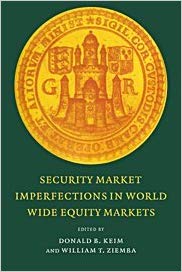 Editors: Donald B. Keim and William T. Ziemba
Editors: Donald B. Keim and William T. Ziemba
Publisher: Cambridge University Press – 531 pages
Book Review by: Sonu Chandiram
I believe many investors (and some traders as well) ask themselves this all-important question frequently, and that is the primary theme of this book:
Are asset prices predictable or do current prices fully reflect underlying value?
Additionally, I believe they frequently wonder: Does taking more risk lead to higher expected returns?
One of the two editors of this book – William T. Ziemba – organized a week-long seminar to shed light on these issues. It was held May 8-13,1995 at the Isaac Newton Institute for Mathematical Sciences at the University of Cambridge in the United Kingdom. This was followed by an institutional investor workshop on Saturday, May 20. These events were part of a six-month-long (January to June 1995) Financial Markets Symposium.
The chapters that form this book are based on papers written by the attendees to that series of meetings in 1995.
Twenty-five specialists from eight countries – Austria, Canada, Finland, France, Singapore, Switzerland, the United Kingdom, and the United States – authored the 22 chapters of this book that we list below to provide you an overview:
- Security market imperfections: an overview
- Part I – An Overview of Cross-Sectional Patterns in Stock Returns
- The cross-section of common stock returns: a review of the evidence and some new findings
- Beta and book to market: is the glass half full or half empty?
- The psychology of over-reaction and under-reaction in world equity markets
- A view of the current status of the size anomaly
- The demise of size
- Direct evidence of non-trading of NYSE and AMEX stocks
- Part II – Seasonal Patterns in Stock Returns and Other Puzzles
- Is there a January effect?
- Anticipation in the January effect in the US futures markets
- How does Clinton stand up to history? US investment returns and presidential party affiliations
- A long-term examination of the turn-of-the-month effect in the S&P 500
- The closed-end fund puzzle
- Stock splits and ex-date returns for Nasdaq stocks: the effects of investor trading and bid-ask spreads
- Part III – International Evidence
- Canadian security market anomalies
- Seasonal anomalies in the Italian stock market, 1973-1993
- Efficiency and anomalies in the Turkish stock market
- Efficiency and anomalies in the Finnish stock market
- Characteristics-based premia in emerging markets: sector-neutrality, cycles, and cross-market correlations
- Anomalies in the Asian stock markets
- Japanese security market regulations, 1990-1994
- Predicting returns on the Tokyo stock market
- High stock market returns before holidays: international evidence and additional tests
This book is based primarily on the theme of predictability of equity stock market returns. The degrees of predictability are sometimes referred to as ‘security market imperfections’ and sometimes they are termed ‘anomalies’ or as ‘seasonal irregularities’ the research findings presented by some of the authors try to address the difficult question of the existence of true market imperfections versus changing risk.
The authors broadly categorize the ‘imperfections’ in two ways:
- Cross-sectional, where the aim is to predict the differences in returns of individual stocks or groups of stocks
- Time series, where the aim is to predict the time periods in which particular indices such as small or large capitalized equities have high or low returns
The authors also discuss, among many other stock-market-related matters :
- Closed and country funds
- Liquidity aspects
- The effects of holidays on stock buying and selling
- Many markets worldwide, big, medium-sized, and small
- Measurement of risk and prediction models
- High returns of equities in January
- Psychology of financial markets
- Presidential elections
- Relationship of small and large stocks at the turn of the year
- Stock splits
- Turn of the month effects
This is an interesting book for investors in stock market equities, as well as traders of many varieties. There is much in it to consider that could be useful to you based on your current knowledge and success in the stock markets.
Editors:
Donald B. Keim is the John B. Neff Professor of Finance at the Wharton School of Finance at the University of Pennsylvania in Philadelphia.
William T. Ziemba is the Alumni Professor of Management Science at the University of British Columbia in Canada.






